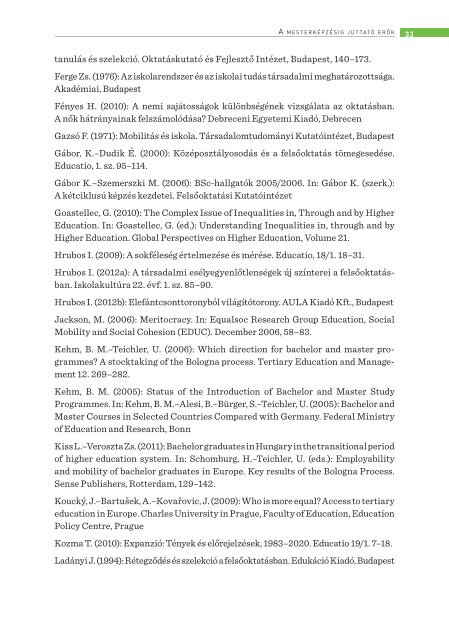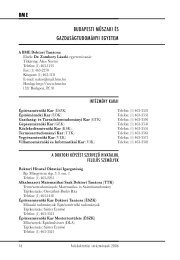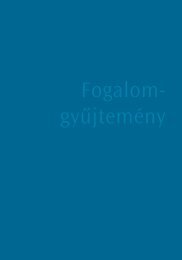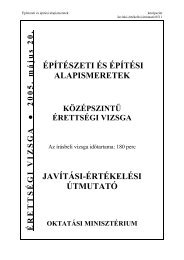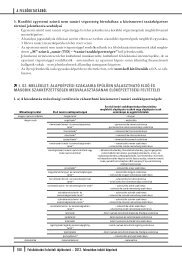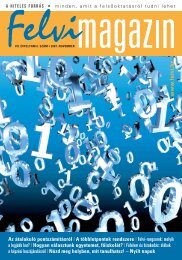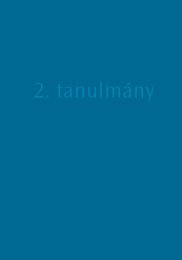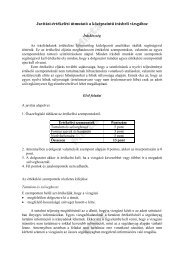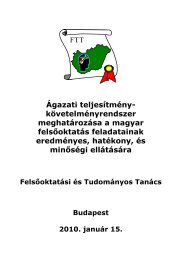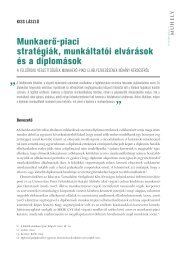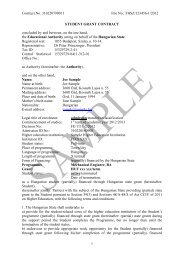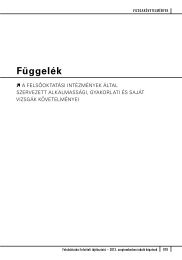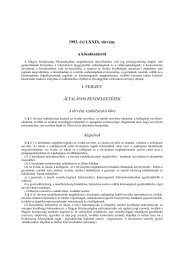- Page 1 and 2: Frissdiplomások 2011 Educatio Tár
- Page 3 and 4: Tartalomjegyzék Előszó . . . . .
- Page 5 and 6: 5 elŐSzÓ A magyarországi Diplom
- Page 7 and 8: E L Ő S Z Ó 7 pontos és hiteles
- Page 9 and 10: 9 Veroszta Zsuzsanna a meSTerkéPz
- Page 11 and 12: A M E S T E R K É P Z É S I G J U
- Page 13 and 14: A M E S T E R K É P Z É S I G J U
- Page 15 and 16: A M E S T E R K É P Z É S I G J U
- Page 17 and 18: A M E S T E R K É P Z É S I G J U
- Page 19 and 20: A M E S T E R K É P Z É S I G J U
- Page 21 and 22: A M E S T E R K É P Z É S I G J U
- Page 23 and 24: A M E S T E R K É P Z É S I G J U
- Page 25 and 26: A M E S T E R K É P Z É S I G J U
- Page 27 and 28: A M E S T E R K É P Z É S I G J U
- Page 29 and 30: A M E S T E R K É P Z É S I G J U
- Page 31: A M E S T E R K É P Z É S I G J U
- Page 35 and 36: A M E S T E R K É P Z É S I G J U
- Page 37 and 38: 37 Szemerszki Marianna TaNUlÁSI UT
- Page 39 and 40: T A N U L Á S I U T A K É S K É
- Page 41 and 42: T A N U L Á S I U T A K É S K É
- Page 43 and 44: T A N U L Á S I U T A K É S K É
- Page 45 and 46: T A N U L Á S I U T A K É S K É
- Page 47 and 48: T A N U L Á S I U T A K É S K É
- Page 49 and 50: T A N U L Á S I U T A K É S K É
- Page 51 and 52: T A N U L Á S I U T A K É S K É
- Page 53 and 54: T A N U L Á S I U T A K É S K É
- Page 55 and 56: T A N U L Á S I U T A K É S K É
- Page 57 and 58: T A N U L Á S I U T A K É S K É
- Page 59 and 60: T A N U L Á S I U T A K É S K É
- Page 61 and 62: T A N U L Á S I U T A K É S K É
- Page 63 and 64: T A N U L Á S I U T A K É S K É
- Page 65 and 66: T A N U L Á S I U T A K É S K É
- Page 67 and 68: 67 Kiss László „alaCSoNy STÁTU
- Page 69 and 70: A L A C S O N Y S T Á T U S Z Ú S
- Page 71 and 72: A L A C S O N Y S T Á T U S Z Ú S
- Page 73 and 74: A L A C S O N Y S T Á T U S Z Ú S
- Page 75 and 76: A L A C S O N Y S T Á T U S Z Ú S
- Page 77 and 78: A L A C S O N Y S T Á T U S Z Ú S
- Page 79 and 80: A L A C S O N Y S T Á T U S Z Ú S
- Page 81 and 82: A L A C S O N Y S T Á T U S Z Ú S
- Page 83 and 84:
A L A C S O N Y S T Á T U S Z Ú S
- Page 85 and 86:
A L A C S O N Y S T Á T U S Z Ú S
- Page 87 and 88:
A L A C S O N Y S T Á T U S Z Ú S
- Page 89 and 90:
A L A C S O N Y S T Á T U S Z Ú S
- Page 91 and 92:
A L A C S O N Y S T Á T U S Z Ú S
- Page 93 and 94:
93 Gáti Annamária-Róbert Péter
- Page 95 and 96:
M U N K A V Á L L A L Á S A T A N
- Page 97 and 98:
M U N K A V Á L L A L Á S A T A N
- Page 99 and 100:
M U N K A V Á L L A L Á S A T A N
- Page 101 and 102:
M U N K A V Á L L A L Á S A T A N
- Page 103 and 104:
M U N K A V Á L L A L Á S A T A N
- Page 105 and 106:
M U N K A V Á L L A L Á S A T A N
- Page 107 and 108:
M U N K A V Á L L A L Á S A T A N
- Page 109 and 110:
M U N K A V Á L L A L Á S A T A N
- Page 111 and 112:
111 Sági Matild PÁlyakezDŐ DIPlo
- Page 113 and 114:
P Á LYA K E Z D Ő D I P L O M Á
- Page 115 and 116:
P Á LYA K E Z D Ő D I P L O M Á
- Page 117 and 118:
P Á LYA K E Z D Ő D I P L O M Á
- Page 119 and 120:
P Á LYA K E Z D Ő D I P L O M Á
- Page 121 and 122:
P Á LYA K E Z D Ő D I P L O M Á
- Page 123 and 124:
P Á LYA K E Z D Ő D I P L O M Á
- Page 125 and 126:
P Á LYA K E Z D Ő D I P L O M Á
- Page 127 and 128:
P Á LYA K E Z D Ő D I P L O M Á
- Page 129 and 130:
P Á LYA K E Z D Ő D I P L O M Á
- Page 131 and 132:
P Á LYA K E Z D Ő D I P L O M Á
- Page 133 and 134:
P Á LYA K E Z D Ő D I P L O M Á
- Page 135 and 136:
P Á LYA K E Z D Ő D I P L O M Á
- Page 137 and 138:
P Á LYA K E Z D Ő D I P L O M Á
- Page 139 and 140:
P Á LYA K E Z D Ő D I P L O M Á
- Page 141 and 142:
P Á LYA K E Z D Ő D I P L O M Á
- Page 143 and 144:
143 Varga Júlia a PÁlyakezDŐ DIP
- Page 145 and 146:
A PÁ LYA K E Z D Ő D I P L O M Á
- Page 147 and 148:
A PÁ LYA K E Z D Ő D I P L O M Á
- Page 149 and 150:
A PÁ LYA K E Z D Ő D I P L O M Á
- Page 151 and 152:
A PÁ LYA K E Z D Ő D I P L O M Á
- Page 153 and 154:
A PÁ LYA K E Z D Ő D I P L O M Á
- Page 155 and 156:
A PÁ LYA K E Z D Ő D I P L O M Á
- Page 157 and 158:
A PÁ LYA K E Z D Ő D I P L O M Á
- Page 159 and 160:
A PÁ LYA K E Z D Ő D I P L O M Á
- Page 161 and 162:
A PÁ LYA K E Z D Ő D I P L O M Á
- Page 163 and 164:
A PÁ LYA K E Z D Ő D I P L O M Á
- Page 165 and 166:
A PÁ LYA K E Z D Ő D I P L O M Á
- Page 167 and 168:
A PÁ LYA K E Z D Ő D I P L O M Á
- Page 169 and 170:
A PÁ LYA K E Z D Ő D I P L O M Á
- Page 171 and 172:
A PÁ LYA K E Z D Ő D I P L O M Á
- Page 173 and 174:
173 Nyüsti Szilvia-Ceglédi Tímea
- Page 175 and 176:
VÁ N D O R L Ó D I P L O M Á S O
- Page 177 and 178:
VÁ N D O R L Ó D I P L O M Á S O
- Page 179 and 180:
VÁ N D O R L Ó D I P L O M Á S O
- Page 181 and 182:
VÁ N D O R L Ó D I P L O M Á S O
- Page 183 and 184:
VÁ N D O R L Ó D I P L O M Á S O
- Page 185 and 186:
VÁ N D O R L Ó D I P L O M Á S O
- Page 187 and 188:
VÁ N D O R L Ó D I P L O M Á S O
- Page 189 and 190:
VÁ N D O R L Ó D I P L O M Á S O
- Page 191 and 192:
VÁ N D O R L Ó D I P L O M Á S O
- Page 193 and 194:
VÁ N D O R L Ó D I P L O M Á S O
- Page 195 and 196:
VÁ N D O R L Ó D I P L O M Á S O
- Page 197 and 198:
VÁ N D O R L Ó D I P L O M Á S O
- Page 199 and 200:
VÁ N D O R L Ó D I P L O M Á S O
- Page 201 and 202:
VÁ N D O R L Ó D I P L O M Á S O
- Page 203 and 204:
VÁ N D O R L Ó D I P L O M Á S O
- Page 205 and 206:
VÁ N D O R L Ó D I P L O M Á S O
- Page 207 and 208:
VÁ N D O R L Ó D I P L O M Á S O
- Page 209 and 210:
209 Várhalmi Zoltán-Czibik Ágnes
- Page 211 and 212:
M Ű S Z A K I-INFORM A T I K A I
- Page 213 and 214:
M Ű S Z A K I-INFORM A T I K A I
- Page 215 and 216:
M Ű S Z A K I-INFORM A T I K A I
- Page 217 and 218:
M Ű S Z A K I-INFORM A T I K A I
- Page 219 and 220:
M Ű S Z A K I-INFORM A T I K A I
- Page 221 and 222:
M Ű S Z A K I-INFORM A T I K A I
- Page 223 and 224:
M Ű S Z A K I-INFORM A T I K A I
- Page 225 and 226:
M Ű S Z A K I-INFORM A T I K A I
- Page 227 and 228:
M Ű S Z A K I-INFORM A T I K A I
- Page 229 and 230:
M Ű S Z A K I-INFORM A T I K A I
- Page 231 and 232:
231 Chrappán Magdolna elégeDeTTS
- Page 233 and 234:
E L É G E D E T T S É G É S M O
- Page 235 and 236:
E L É G E D E T T S É G É S M O
- Page 237 and 238:
E L É G E D E T T S É G É S M O
- Page 239 and 240:
E L É G E D E T T S É G É S M O
- Page 241 and 242:
E L É G E D E T T S É G É S M O
- Page 243 and 244:
E L É G E D E T T S É G É S M O
- Page 245 and 246:
E L É G E D E T T S É G É S M O
- Page 247 and 248:
E L É G E D E T T S É G É S M O
- Page 249 and 250:
E L É G E D E T T S É G É S M O
- Page 251 and 252:
E L É G E D E T T S É G É S M O
- Page 253 and 254:
E L É G E D E T T S É G É S M O
- Page 255 and 256:
E L É G E D E T T S É G É S M O
- Page 257 and 258:
E L É G E D E T T S É G É S M O
- Page 259 and 260:
E L É G E D E T T S É G É S M O
- Page 261 and 262:
E L É G E D E T T S É G É S M O
- Page 263 and 264:
E L É G E D E T T S É G É S M O
- Page 265 and 266:
265 Kiss Paszkál PÁlyakezDŐk mUN
- Page 267 and 268:
PÁ L Y A K E Z D Ő K M U N K Á V
- Page 269 and 270:
PÁ L Y A K E Z D Ő K M U N K Á V
- Page 271 and 272:
PÁ L Y A K E Z D Ő K M U N K Á V
- Page 273 and 274:
PÁ L Y A K E Z D Ő K M U N K Á V
- Page 275 and 276:
PÁ L Y A K E Z D Ő K M U N K Á V
- Page 277 and 278:
PÁ L Y A K E Z D Ő K M U N K Á V
- Page 279 and 280:
PÁ L Y A K E Z D Ő K M U N K Á V
- Page 281 and 282:
PÁ L Y A K E Z D Ő K M U N K Á V
- Page 283 and 284:
PÁ L Y A K E Z D Ő K M U N K Á V
- Page 285 and 286:
PÁ L Y A K E Z D Ő K M U N K Á V
- Page 287 and 288:
PÁ L Y A K E Z D Ő K M U N K Á V
- Page 289 and 290:
PÁ L Y A K E Z D Ő K M U N K Á V
- Page 291 and 292:
PÁ L Y A K E Z D Ő K M U N K Á V
- Page 293 and 294:
293 Absztraktok DPR.indd 293 2/19/1
- Page 295 and 296:
295 CHRAPPÁN MAGDOLNA elégeDeTTS
- Page 297 and 298:
A B S Z T R A K T O K 297 KISS PASZ
- Page 299 and 300:
A B S Z T R A K T O K 299 ságokkal
- Page 301 and 302:
301 Szerzőink, szaklektoraink DPR.
- Page 303 and 304:
303 Ceglédi Tímea Diplomáját a
- Page 305 and 306:
S Z E R Z Ő I N K , S Z A K L E K
- Page 307 and 308:
307 Függelék DPR.indd 307 2/19/13
- Page 309 and 310:
309 mÓDSzerTaNI leÍrÁS Frissdipl
- Page 311 and 312:
F Ü G G E L É K 311 Intézmény E
- Page 313 and 314:
F Ü G G E L É K 313 változó bev
- Page 315 and 316:
315 FrISSDIPlomÁSok 2011 - kUTaTÁ
- Page 317 and 318:
F Ü G G E L É K 317 1.2.3. A vég
- Page 319 and 320:
F Ü G G E L É K 319 2. Egyéb fel
- Page 321 and 322:
F Ü G G E L É K 321 Nem ismeri Na
- Page 323 and 324:
F Ü G G E L É K 323 2.8.2. … a
- Page 325 and 326:
F Ü G G E L É K 325 3.2.4. Ön ek
- Page 327 and 328:
F Ü G G E L É K 327 4. Munkaerő-
- Page 329 and 330:
F Ü G G E L É K 329 5. Jelenlegi
- Page 331 and 332:
F Ü G G E L É K 331 5.8. Hány al
- Page 333 and 334:
F Ü G G E L É K 333 [8 -] Száll
- Page 335 and 336:
F Ü G G E L É K 335 5.19.2. Véle
- Page 337 and 338:
F Ü G G E L É K 337 7.5.2.1. Az i
- Page 339 and 340:
DPR.indd 339 2/19/13 7:50 PM


